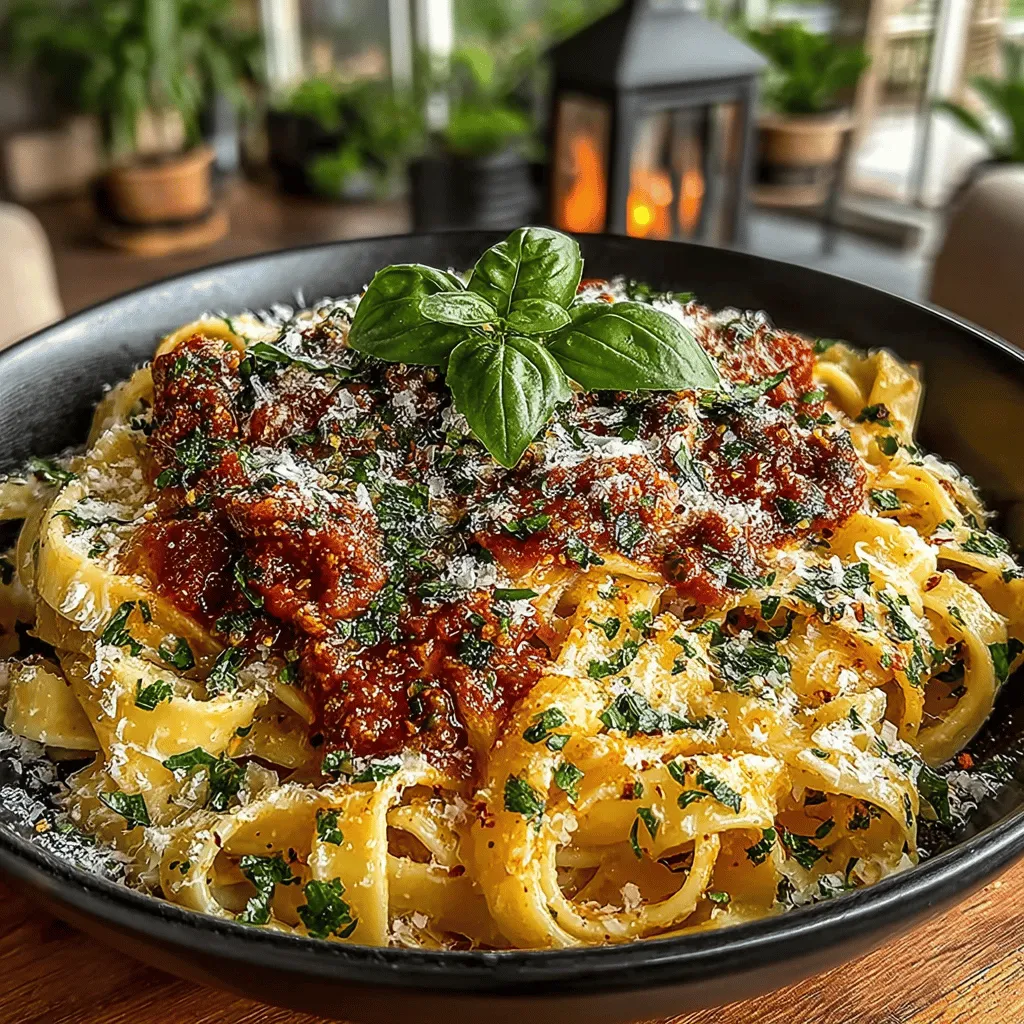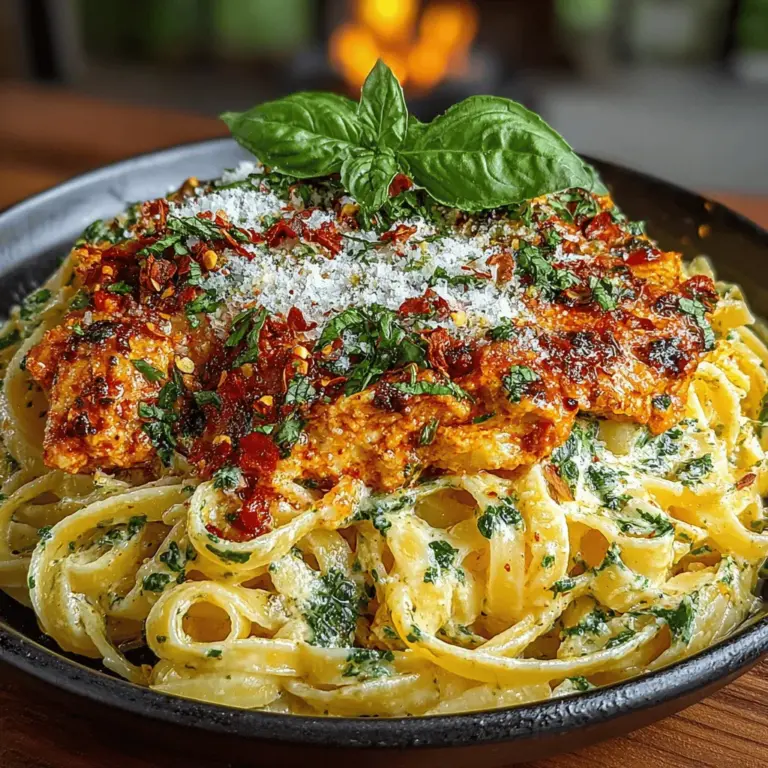Creamy Tomato Basil Pasta Recipe
When it comes to comfort food, few dishes can compete with creamy tomato basil pasta. This delightful recipe combines the rich flavors of tomatoes and fresh basil with the luxurious texture of cream, creating a dish that is both satisfying and indulgent. Whether you’re looking for a quick weeknight meal or an impressive dish to serve guests, creamy tomato basil pasta fits the bill perfectly. Its simplicity lies in the way it brings together a handful of quality ingredients to create a symphony of flavor that delights the palate.
One of the most appealing aspects of creamy tomato basil pasta is its versatility. This dish can easily be adapted to suit various occasions, whether it’s a cozy family dinner, a festive gathering, or even a romantic evening at home. The bright, fresh flavors of basil and tomato evoke the warmth of summer, while the creamy sauce provides a comforting embrace during colder months. With this recipe, you can impress your family or guests without spending hours in the kitchen.
Understanding the Ingredients
To create a truly memorable creamy tomato basil pasta, understanding the role of each ingredient is crucial. Let’s break down the key components that come together to create this delicious dish:
Pasta Choices
The foundation of any pasta dish is, of course, the pasta itself. Both spaghetti and fettuccine work beautifully in this recipe. Spaghetti, with its long, thin strands, can twirl elegantly around your fork, making each bite a delight. On the other hand, fettuccine, with its flat, wide noodles, can hold onto the creamy sauce in a way that makes every mouthful feel indulgent. The choice ultimately comes down to personal preference, but either option will yield a satisfying meal.
Quality Olive Oil
When preparing creamy tomato basil pasta, the importance of using high-quality olive oil cannot be overstated. Not only does it serve as the base for sautéing the garlic, but it also adds depth and richness to the sauce. The flavor profile of olive oil can vary significantly, with some oils offering a fruity and peppery finish. Choosing an extra virgin olive oil will elevate the dish, bringing a touch of sophistication to your creamy pasta.
Garlic
Garlic is another key ingredient in this recipe, providing an aromatic foundation that enhances the overall flavor profile of the dish. When sautéed, garlic releases its essential oils, resulting in a warm, inviting aroma that fills your kitchen. However, it’s important to sauté garlic gently to avoid burning, which can impart a bitter taste. Properly cooked garlic adds a fragrant undertone that perfectly complements the sweetness of the tomatoes.
Crushed Tomatoes
The star of the sauce is undoubtedly the crushed tomatoes. Using quality crushed tomatoes will contribute to a rich and flavorful sauce that serves as the backbone of this dish. The natural sweetness of the tomatoes balances beautifully with the cream, creating a harmonious blend of flavors. Additionally, crushed tomatoes have a smoother texture compared to diced or whole tomatoes, making them ideal for a creamy sauce.
Heavy Cream
To achieve that signature creaminess that defines this pasta dish, heavy cream is essential. It not only adds a luscious texture but also mellows the acidity of the tomatoes, creating a balanced flavor profile. The creaminess of the sauce envelops the pasta, ensuring each bite is rich and satisfying.
Sugar
While it may seem counterintuitive, a touch of sugar plays a significant role in balancing the acidity of the tomatoes. This small addition helps to round out the flavors and enhances the overall taste of the sauce. It’s a simple trick that can make a big difference in the final dish, ensuring that the sauce is well-rounded and delicious.
Fresh Basil
Fresh basil is the final touch that brings this dish to life. Its vibrant green color adds visual appeal, while its aromatic flavor infuses the dish with freshness. The bright notes of basil contrast beautifully with the creaminess of the sauce, making each bite a burst of flavor. For the best results, use fresh basil whenever possible, as it has a more intense flavor compared to dried versions.
Parmesan Cheese
To finish off your creamy tomato basil pasta, a sprinkle of freshly grated Parmesan cheese adds depth and richness. This umami-packed ingredient enhances the overall flavor, creating a satisfying finish to the dish. Parmesan cheese not only provides a savory note but also contributes to the creaminess of the sauce when melted.
Optional Ingredients for Customization
While the core ingredients are essential for a classic creamy tomato basil pasta, there’s always room for customization. For those who enjoy a little heat, consider adding a pinch of red pepper flakes to the sauce. This simple addition can elevate the dish, providing a delightful kick that complements the creamy tomato base.
Preparation Steps Explained
Now that we have a solid understanding of the ingredients, let’s dive into the preparation steps that will lead you to a delectable creamy tomato basil pasta.
Cooking the Pasta
The journey to a perfect creamy tomato basil pasta begins with the pasta itself. Start by bringing a large pot of salted water to a boil. Salting the water is crucial, as it enhances the flavor of the pasta. Once boiling, add your choice of spaghetti or fettuccine. Be sure to cook the pasta to al dente, which means it should be firm to the bite. This ensures that the pasta holds its shape and texture, even after being tossed in the creamy sauce.
As the pasta cooks, it’s also important to reserve some pasta water before draining. This starchy water can be a game-changer when it comes to adjusting the consistency of your sauce later on.
Sautéing the Garlic
While the pasta is cooking, it’s the perfect time to sauté the garlic. In a large skillet, drizzle in some high-quality olive oil and heat it over medium heat. Once the oil is warm, add minced garlic and cook it gently. Stir frequently to prevent burning, which can happen quickly if the heat is too high. You want the garlic to become fragrant and golden, not brown and bitter. This step is crucial, as the sautéed garlic lays the groundwork for the flavor profile of your sauce.
Making the Tomato Sauce
With the garlic perfectly sautéed, it’s time to create the rich tomato base. Carefully add the crushed tomatoes to the skillet and stir to combine with the garlic and olive oil. Allow the mixture to come to a gentle simmer. At this point, you can also add a pinch of sugar to balance the acidity of the tomatoes. Allow the sauce to simmer for about 10-15 minutes, stirring occasionally. This simmering process is key — it allows the flavors to meld and develop, resulting in a sauce that is deliciously rich and satisfying.
As the sauce simmers, prepare to incorporate the heavy cream. Once the sauce has thickened and the flavors have intensified, you’ll add the cream to create that signature creamy texture.
Stay tuned for the next part of the recipe, where we’ll delve into the final steps of bringing this creamy tomato basil pasta together and serving it to perfection.

Seasoning and Balancing Flavors
The heart of any good dish lies in its seasoning and the balance of flavors. For creamy tomato basil pasta, start with the foundational flavors: salt, pepper, and a hint of sweetness. When cooking your dish, taste as you go. This ensures that the acidity of the tomatoes is balanced with sugar, which cuts through the acidity and enhances the overall flavor profile. Fresh basil not only adds a fragrant aroma but also a slightly peppery flavor that beautifully complements the richness of the cream. Don’t forget to season your pasta water generously with salt, as this is the first opportunity to infuse the pasta with flavor.
Creating the Creamy Sauce
Importance of Temperature Control When Adding Cream
The key to a velvety smooth sauce lies in the careful addition of cream. After cooking your garlic and tomatoes, allow the mixture to simmer for a few minutes before introducing the cream. This brief cooking time allows the tomatoes to break down and meld with the garlic, creating a robust base. When you add the cream, ensure the heat is low to prevent it from curdling. Gradually pouring in the cream while stirring continuously helps to maintain a stable emulsion, resulting in a luscious sauce that clings beautifully to the pasta.
Achieving the Right Consistency for the Sauce
The goal is to achieve a sauce that is creamy but not overly thick. It should coat the pasta while allowing it to shine as the star of the dish. If your sauce feels too thick, don’t hesitate to add a splash of pasta water. This starchy liquid not only thins the sauce but also helps it adhere to the pasta. Start with small amounts and adjust until you reach your desired consistency.
Combining Ingredients
Techniques for Folding in Pasta and Ensuring Even Coating
Once your sauce reaches the perfect consistency, it’s time to combine it with the pasta. Use a large skillet or a pot to facilitate this process. Add the drained pasta directly to the sauce, and use tongs or a large spoon to gently fold the pasta into the sauce. This method ensures that each strand or piece is evenly coated without breaking the pasta. The goal is to achieve a harmonious blend where the pasta is enveloped in the creamy sauce, creating a tantalizing dish that looks as good as it tastes.
Adjusting the Sauce’s Consistency Using Reserved Pasta Water
As you combine the pasta and sauce, you might find that it still needs a little adjustment. This is where the reserved pasta water comes into play. Add it gradually, mixing well until you achieve a silky texture. The starch in the water helps bind the sauce to the pasta while enhancing its creaminess. Remember, it’s easier to add more liquid than to take it away, so add sparingly until it’s just right.
Finishing Touches
Incorporating Cheese for Flavor and Texture
No creamy tomato basil pasta is complete without the addition of cheese. Grated Parmesan or Pecorino Romano not only adds a salty, umami flavor but also contributes a creamy texture that elevates the dish. Stir the cheese in after the pasta has been combined with the sauce to ensure it melts beautifully without clumping. For a more indulgent finish, consider adding a dollop of ricotta or a sprinkle of mozzarella for a creamy contrast.
Tips on Garnishing for Visual Appeal
Presentation matters, especially when it comes to a dish as vibrant as creamy tomato basil pasta. To elevate your serving, consider garnishing with fresh basil leaves, which add a pop of color and freshness. A light drizzle of high-quality olive oil can enhance the flavor while giving the dish an appealing sheen. Additionally, a sprinkle of freshly cracked black pepper or a dusting of extra cheese can add to the visual allure of your pasta.
Serving Suggestions
Presentation Tips for an Elegant Dining Experience
To create an elegant dining experience, plate your creamy tomato basil pasta with care. Use warmed plates to keep the dish hot. Twirl the pasta into a nest in the center of the plate for a sophisticated look. A final touch of fresh basil and a sprinkle of cheese can elevate the presentation even further.
Ideas for Serving
Consider serving your creamy tomato basil pasta with a drizzle of olive oil or a few chili flakes for an added layer of flavor. You can also offer freshly baked bread on the side, perfect for soaking up any leftover sauce. For a complete meal, pair it with a light arugula salad dressed in lemon vinaigrette to cut through the richness of the pasta.
Pairing Suggestions
For an ideal pairing, a crisp white wine such as Sauvignon Blanc or a light red like Pinot Noir complements the dish beautifully. If you prefer non-alcoholic options, serve sparkling water with lemon for a refreshing contrast.
Nutritional Information
Breakdown of Key Nutritional Components
Creamy tomato basil pasta is not just delicious; it can also be a well-rounded meal. Here’s a breakdown of the key nutritional components per serving:
– Calories: Approximately 500-600 calories, depending on portion size and ingredients used.
– Macronutrients:
– Carbohydrates: 70-80g (primarily from pasta)
– Protein: 15-20g (mainly from cheese and optional proteins)
– Fats: 20-30g (from cream and cheese)
Dietary Considerations
For those watching their caloric intake, this dish can be made lighter by using low-fat cream or substituting with a non-dairy alternative. Additionally, using whole grain pasta can increase the fiber content, making it more filling and nutritious.
Making the Recipe Lighter or Healthier
Consider adding more vegetables to boost the nutritional profile. Spinach, bell peppers, or zucchini can easily be incorporated into the sauce. For a protein boost, grilled chicken, shrimp, or chickpeas can be great additions without significantly altering the dish’s character.
Variations and Customizations
Suggestions for Adding Proteins
To make your creamy tomato basil pasta more filling, consider adding proteins. Grilled chicken breast, sautéed shrimp, or even crispy tofu can complement the dish beautifully. Simply cook the protein separately and fold it in at the end for a hearty meal.
Ideas for Incorporating Vegetables
Adding vegetables is a fantastic way to enhance the dish’s nutritional value. Spinach or kale can be stirred into the sauce at the end until just wilted. Bell peppers or zucchini can be sautéed alongside the garlic and tomatoes, infusing the sauce with extra flavor and color.
Options for Dietary Adaptations
For those following a vegan diet, substitute the cream with coconut milk or cashew cream and omit the cheese. Gluten-free pasta is widely available, allowing those with gluten sensitivities to enjoy this dish without worry. Experimenting with these alternatives can lead to a deliciously creamy tomato basil pasta that fits various dietary needs.
Conclusion
Creamy tomato basil pasta is a delightful dish that combines the richness of cream with the fresh flavors of tomatoes and basil, creating a comforting meal that is sure to please any palate. Whether you’re cooking for yourself or entertaining guests, this recipe provides endless opportunities for customization and creativity. We encourage you to try making this dish your own—experiment with different proteins, vegetables, and garnishes to create a version that brings joy to your table. The satisfaction of crafting a homemade meal that delights both the taste buds and the senses is truly unparalleled. Enjoy the process and, most importantly, savor every bite!


